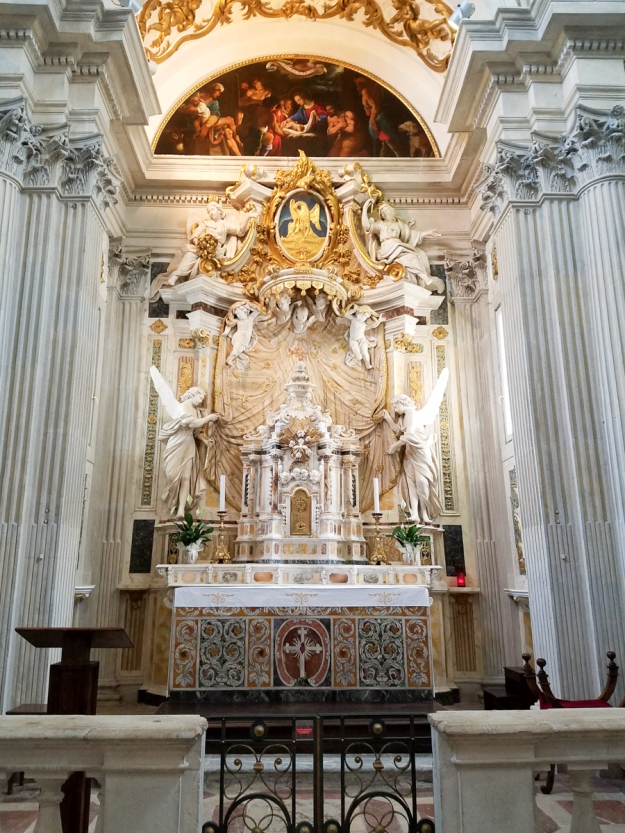The following is from the homily delivered by Monsignor Mark Lane, Vicar General of the Diocese of Richmond, at Father Kauffmann’s Funeral Mass, Friday, June 23, 2017 at Saint Benedict parish. Monsignor Lane choose the scripture readings, which were 1 Kings 19:11-13a, Philippians 4:4-9, and Luke 12:35-40.
In the face of Father Kauffmann’s sudden death we may feel that God has visited us as heavy wind, crashing rocks, and earthquake. We need to listen for that small whisper.
If anybody was meant to be a priest, it was Father Kauffmann. He was a man of the Eucharist who brought solemnity to that moment of mystery. And as the prayer says, we were to be as holy as the actions we perform.
This last trip of his was to follow some of the roads travelled by Saint Francis. He little knew where his journey would end.
Baptized James, known in the family as Jimmy, called Father Jim Kauffmann and for those who experienced him, called the Energizer Bunny. The man never stopped. And was able to do it all with a sense of enthusiasm and joy. All you had to do was hear the laugh.
He was a man who did not just do the functions of the parish like staff meetings and budgets but who was explicit in the love he had for the people, whether in Saint Augustine’s, Saint John’s in Waynesboro, Saint Mary’s in Ladysmith, Saint Benedict, Sacred Heart in Norfolk, and recently at Saint Bede’s.
He touched your lives and mine in seven different ways… he did what a priest is meant to do. He ministered most effectively with the sick and the senior members of the Church.
Father Jim had many facets but there was one area in which he excelled: it was to capture words. For Father Jim Kauffmann, it was about words. Words were not just the printed page but words that had a history and that history had power. Words were not just sounds. He told us, as the Church does, a Word is spoken and the world is brought into being, and it’s a word that makes us into the image of God.
And it was in the Scriptures he really shined. He saw the Word of God as our source of truth. If we imitate his scholarship, his word is something we are called to know, to meditate on and to speak to ourselves. He did it in Hebrew, Aramaic, Latin, Greek, and Syriac! We are to plumb its depths and not leave it on a page, and he did it with humility and without pretense.
But it wasn’t just the Scriptures; he could talk about Augustine, Virgil, and Dante, and would try to make us understand… and if we didn’t the enthusiasm kept us going.
Can we in the midst of pain with Paul know that the Lord is near to us here, and if the pain remains and the anxiety advances, that we are to pray?
“I have so much more to do. I want to go to India and study Syriac” was the way he ended our last conversation, Sunday night.
He didn’t know the “more” would be eternal life, but that was the “more” Christ had for him.
But this is the theme of all believers in Christ: we have more to do. The more in this context are the prayers and comforts we can bring to each other. The more may be turning to Christ and learning how to rely only on Him.
We have so much more to do. To make Christ real to people. To share the forgiveness we have received. To reconcile with neighbor; to bring hope where needed. This is our “more” and we would do well to honor Christ and his servant Father Jim in this way.
We are here today to do service to his life and death and with the Scripture and the Eucharist to offer his soul to God, and try to make sense in our own lives of sudden death.
The answer is fulfilled in the Gospel just read: we know not the day or hour when the Master will return. We need to be prepared, and Father Kauffmann was. He received the Last Rites and the Eucharist which saw him from this life to eternity. Are we prepared?
Have we become any better because death visited us? Do we live the Gospel at a deeper depth? Do we take time to love and cherish people in a different way than we did before we got the news? Death is a fine teacher and reminder for Christians if only we listen.
At the funeral. Concelebrating priests from L-R: Rev. Anthony Marques, Pastor of Saint Benedict; Most Rev. Timothy Broglio, Archbishop of the Military Services, USA; Rev. Tom Mattingly, Pastor, Saint Olaf in Norge, Virginia; Most Rev. Francis X. DiLorenzo, Bishop of Richmond (celebrant); Rev. Msgr. Mark Lane; and Rev. Msgr. Timothy Keeney, Pastor of Saint Bede in Williamsburg.
The Recessional begins, led by seminarians of the Diocese of Richmond, many of whom were much influenced by Father Kauffmann.







































































































































You must be logged in to post a comment.